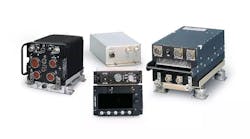ARLINGTON, Va. – U.S. military researchers needed a company to develop small RF receivers, transmitters, and antennas for space-constrained RF and microwave applications in sensors and communications. They found their solution from SRI International in Menlo Park, Calif.
Officials of the U.S. Defense Advanced Research Projects Agency (DARPA) in Arlington, Va., announced a $16.8 million contract to SRI International on Wednesday for the Macaroni project to develop tiny RF receivers and transmitters. Details of the project are secret.
DARPA is asking SRI International engineers to develop RF and microwave components that not only should exceed today's state of the art, but also should seek to overcome long-established design limitations of the so-called Chu Limit that constrains the bandwidth of data that can be sent and received from small antennas.
Measurement and control of the electromagnetic spectrum is a key research area the U.S. Department of Defense (DOD), researchers point out. Spectrum dominance requires quick and efficient control of electromagnetic radiation from DC to the X-ray regime.
Related: RF and microwave designers take-on the cluttered spectrum
The primary challenge of the Macaroni project that SRI International will face involves receivers and transmitters that are much smaller in size than the wavelength of the sent and received electromagnetic radiation.
In classical antenna theory, the sensitivity-bandwidth product is fundamentally limited by the shape and size of the antenna. This performance degrades significantly as the antenna size becomes much smaller than the electromagnetic wavelength of operation.
Yet size-, weight-, and power- (SWaP)-constrained applications are driving efforts to move beyond traditional constraints, and develop efficient, electrically small antennas still presents a challenge.
Recent advances in quantum sensors, materials science, electromagnetic shielding, laser technology, resonators, cryogenic systems, and vacuum components have pushed the state of the art in sensing technologies. As these enabling technologies improve, a wider variety of protocols and methodologies become possible and previous notions of the performance limits require validation, researchers say.
For transmitters, new insights in active antenna technology, control schemes, methods of impedance matching, and strategies for volume filling also present new opportunities. Recent efforts in piezoelectrics, magnetoelectrics, high-index materials, and multiferroic materials may be leveraged to improve the efficiency trade space for small antennas.
DARPA researchers are asking SRI International for transmit and receive technologies that can achieve performance beyond the Chu limit that can incorporate electric and magnetic technologies -- especially in solutions that minimize the antenna size relative to the operating wavelength.
Related: Radar technology looks to the future
The Macaroni program is a 45-month three-phase program with an 18-month first phase, an 18-month second phase, and a nine-month third phase. The project emphasizes two technical areas: receivers and transmitters.
SRI International will focus on receiver work involving receive sensitivity, link closure, and systems integration. The company's transmitter work will focus on transmitter strength, demonstrating a transmitter system, and system ruggedization.
For more information contact SRI International online at https://www.sri.com, or DARPA at www.darpa.mil/program/macaroni.



